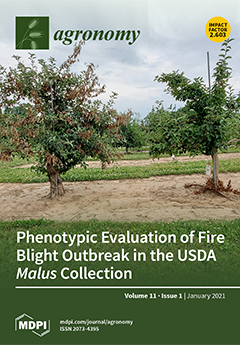Topography affects soil hydrological, pedological, and biochemical processes and may influence nitrous oxide (N
2O) emissions into the atmosphere. While N
2O emissions from agricultural fields are mainly measured at plot scale and on flat topography, intrafield topographical and crop growth
[...] Read more.
Topography affects soil hydrological, pedological, and biochemical processes and may influence nitrous oxide (N
2O) emissions into the atmosphere. While N
2O emissions from agricultural fields are mainly measured at plot scale and on flat topography, intrafield topographical and crop growth variability alter soil processes and might impact N
2O emissions. The objective of this study was to examine the impact of topographical variations on crop growth period dependent soil N
2O emissions at the field scale. A field experiment was conducted at two agricultural farms (Baggs farm; BF and Research North; RN) with undulating topography. Dominant slope positions (upper, middle, lower and toeslope) were identified based on elevation difference. Soil and gas samples were collected from four replicated locations within each slope position over the whole corn growing season (May–October 2019) to measure soil physio-chemical properties and N
2O emissions. The N
2O emissions at BF ranged from −0.27 ± 0.42 to 255 ± 105 g ha
−1 d
−1. Higher cumulative emissions were observed from the upper slope (1040 ± 487 g ha
−1) during early growing season and from the toeslope (371 ± 157 g ha
−1) during the late growing season with limited variations during the mid growing season. Similarly, at RN farm, (emissions ranged from −0.50 ± 0.83 to 70 ± 15 g ha
−1 d
−1), the upper slope had higher cumulative emissions during early (576 ± 132 g ha
−1) and mid (271 ± 51 g ha
−1) growing season, whereas no impact of slope positions was observed during late growing season. Topography controlled soil and environmental properties differently at different crop growth periods; thus, intrafield variability must be considered in estimating N
2O emissions and emission factor calculation from agricultural fields. However, due to large spatial variations in N
2O emissions, further explorations into site-specific analysis of individual soil properties and their impact on N
2O emissions using multiyear data might help to understand and identify hotspots of N
2O emissions.
Full article





